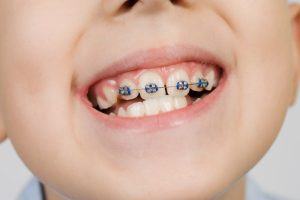
Quite a few parents who come to see us are confused because their child’s dentist has recommended that they receive braces, but they still have most of their baby teeth. What is the point of straightening them if they are just going to fall out? While this approach might seem counterintuitive, applying braces to the baby teeth is a relatively common orthodontic practice, and it offers several benefits for children. How does it work? Find out more in today’s blog.
Why It’s Important to Straighten the Baby Teeth
Before delving into how early-age orthodontics works, it’s important to first understand why misaligned baby teeth need to be straightened in the first place.
A child’s first set of teeth are vitally important to their abilities to speak and eat, but they also have another job—creating the path for the adult teeth to come in properly. Crooked baby teeth can actually prevent the adult teeth from erupting correctly, leading to the development of more severe orthodontic problems. By aligning the baby teeth, an orthodontist is not only able to help a child achieve an attractive and functional smile, but they are also giving their future teeth the best possible chance to come in without issue.
How Braces with Baby Teeth Works
The American Association of Orthodontists recommends that every child should receive an orthodontic evaluation around age 8. If an orthodontist notices a problem in a child’s baby teeth, they may recommend they undergo Phase 1 Orthodontics. In our practice, we find that about 10-15% of children can benefit from this treatment. It may involve applying braces to the primary teeth with the goal of creating enough room within the mouth and jawbone for the adult teeth to come in. After a child has worn braces for a year or so, they are removed so the adult teeth can erupt naturally, and then if needed, braces will be used to fix any misalignments. For children who have orthodontic issues due to their bone structure (such as having a narrow face or jaw that causes crowding or a crossbite), we may place an expander, which slowly increases the size of the hard palate to give the teeth more room, and this also helps align the bite.
The Benefits of Early-Age Orthodontics
- It enables a child to develop a strong, healthy, and straight smile, which helps them perform daily tasks more easily.
- Early-age orthodontics can also help a child break habits that might lead to alignment problems in the future, such as thumb or finger sucking.
- The development of the jaw can be directed to prevent crowding in the adult teeth, and this can also give a child a wider, more attractive face.
- With Phase 1 Orthodontics, many problems are treated before they become more complicated or are prevented entirely.
So, if your child’s dentist suggests that they get braces on their baby teeth, listen to them, because it’s likely a good idea! It’s also wise to contact Shirck Orthodontics if your child’s baby teeth have noticeable crowding, crookedness, gaps, or their bite doesn’t line up. By acting quickly, you allow us to give your child a gorgeous smile as efficiently and comfortably as possible!
About the Author
Dr. Jeffrey Shirck is a board-certified orthodontist who has been named as one of Columbus’ Top Orthodontists every year since 2011. He has helped countless children with Phase 1 Orthodontics, and he’s able to tailor the treatment for each patient to ensure the process goes as smoothly as possible. If you think your child could benefit from getting braces on their baby teeth, we invite you to schedule a FREE consultation at Shirck Orthodontics today.

